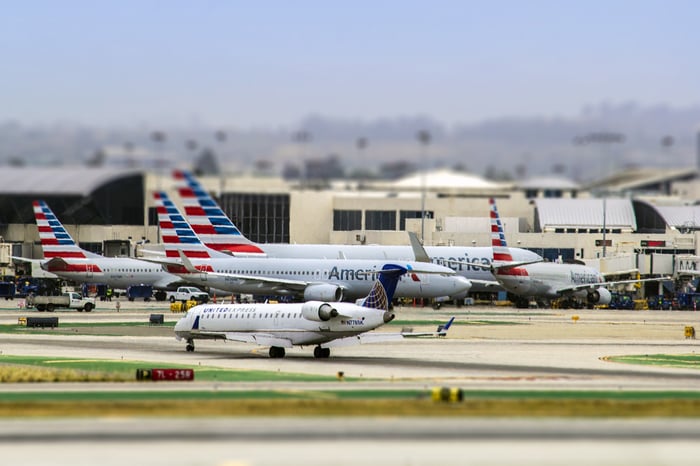Traditionally, the transatlantic market has been a key profit center for the U.S. legacy carriers. Together with their European joint venture partners, American Airlines (AAL -8.49%), Delta Air Lines (DAL 0.21%), and United Continental (UAL -1.31%) have dominated the market. Not surprisingly, this oligopoly situation is good for profit margins.
However, a growing crop of budget carriers -- including no-frills ultra-low cost carriers like WOW Air -- are moving into the transatlantic market. They are already creating visible pricing pressure. Furthermore, budget carriers' transatlantic growth is just getting started. Just last week, WOW Air announced that it will add four new U.S. destinations next spring.
Getting to know the new players
Since 2015, Norwegian and WOW Air have been the two fastest-growing transatlantic budget carriers. Their business models are somewhat different. For example, Norwegian primarily flies widebodies on its transatlantic routes, with point-to-point flights between major cities. Meanwhile, WOW Air primarily uses narrowbodies and routes all flights through its hub in Reykjavik.

WOW Air is a fast-growing transatlantic budget carrier. Image source: WOW Air.
However, there are also some key similarities. First, customers must pay extra for amenities that the legacy carriers still offer for free on overseas flights, such as checked bags, meals, and advance seat selection. Second, both carriers use denser seating configurations than rivals like American Airlines, Delta Air Lines, and United Continental.
As a result, Norwegian and WOW Air are able to offer extremely low base fares. This has led to widespread fare declines for U.S.-Europe flights -- at least for economy passengers.
Transatlantic unit revenue challenges
Sure enough, the U.S. legacy carriers faced acute unit revenue pressure on transatlantic routes last year. Transatlantic passenger revenue per available seat mile (PRASM) fell 7.2% in 2016 at American Airlines. Delta fared somewhat better, with a 6.8% transatlantic PRASM decline last year, while United posted an even steeper 8.4% PRASM drop.
So far, 2017 has been a mixed bag. United Continental has bounced back from its poor 2016 performance, posting PRASM growth in the transatlantic market during the first two quarters. American and Delta continued to face unit revenue pressure, though. Furthermore, even United expects transatlantic PRASM to be flattish this quarter.
WOW Air is growing again
Last week, WOW Air announced plans to expand to four new U.S. destinations next year, all in the Midwest: Detroit, St. Louis, Cleveland, and Cincinnati. While Detroit is a major hub for Delta, the other three cities have little or no transatlantic service today.
WOW Air is offering introductory pricing as low as $99.99 one-way to Iceland, or $149.99 one-way for connecting itineraries to Europe. Obviously, that's dramatically below the prices that legacy carriers would charge.
In many ways, WOW Air is a perfect fit for midsize cities in the eastern half of the U.S. Since most of these cities have few (if any) flights to Europe, travelers have to fly through some hub no matter what. In many cases, flying through Reykjavik is more direct than flying through a U.S. hub. Furthermore, Iceland's strategic location between the U.S. and Europe allows WOW Air to fly lower-cost narrowbodies on these routes, while the legacy carriers mainly use widebodies for their transatlantic flights.
New technology is going to make the problem worse
American, Delta, United, and their European partners have maintained their transatlantic oligopoly for many years for two main reasons. First, most low-cost carriers have avoided operating widebody aircraft. (Norwegian is breaking that precedent in a big way.)

U.S. legacy carriers and their European partners dominate transatlantic flying. Image source: Pixabay.
Second, most narrowbody planes haven't had the range to fly nonstop between the U.S. and Europe -- until now. WOW Air has been able to get around this problem because it is based in Iceland, which is much closer to the U.S. than the rest of Europe.
However, the next-generation narrowbodies from Boeing and Airbus have significantly more range than their older products. (The one exception is the Boeing 757, but that uses outdated 1980s-era technology.) This will allow budget airlines to comfortably fly nonstop between the Northeast U.S. and Western Europe without introducing new aircraft types.
As a result, investors can probably expect the competition to become even more intense in the transatlantic market going forward. As they induct new-technology planes into their fleets, a slew of low-cost carriers could start to chip away at the legacy carriers' dominance on routes between the U.S. and Europe.





